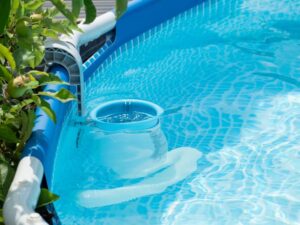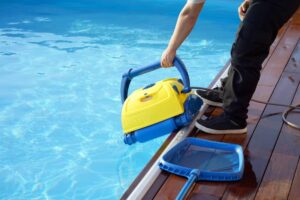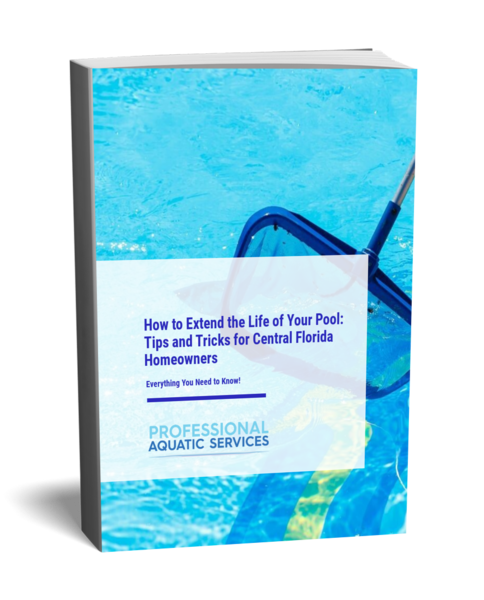In regions such as Orlando, the impact of heavy rain on swimming pools is a crucial topic for every pool owner. The rainy season, often characterized by storms and high humidity, significantly affects pool water’s quality and cleanliness. To guide you, we will equip you with essential information on pool draining and cleaning and provide steps to ensure your pool stays in pristine condition regardless of the weather.
Table of Contents
ToggleDeciding Whether to Drain Your Pool After Rain: A Matter of Severity
The Perfect Plan: Draining and Cleaning Your Pool Post-Rain
Navigating the aftermath of a rainstorm can be a daunting task, especially when it involves pool draining and cleaning. Here are the steps to effectively draining and meticulously cleaning your pool, ensuring it remains crystal clear and safe post-rain.

1. A Spotless Start: Cleaning the Pool Deck
2. Keep it Clear: Remove Debris From The Pool
Next, manually remove any visible debris from the pool using a long-handled leaf net or pool rake. Make sure to regularly empty the skimmer baskets as well, as leaves and other debris often accumulate here. Avoid rushing this process, as hurried movements can push debris further into the pool.
3. Power Up: Turn on the Pump and filter.
Once the pool is clear of larger debris, turn on your pool’s pump and filter system. Let it run for at least 8–12 hours to properly circulate the water and filter out any smaller particles. Do not skip this step even if the water looks clean to the naked eye; small contaminants can still be present.
4. No Algae Allowed: Brush the Pool
Using a specialized pool brush, thoroughly scrub the sides, steps, and bottom of your pool. This process dislodges algae and other deposits stuck to the pool surfaces. However, don’t use brushes with metal bristles on vinyl-lined pools, as it may cause damage.
5. Suck It Up: Vacuum the Pool
Vacuuming removes the dislodged debris and deposits from your pool. If there’s a significant amount of debris, consider manually vacuuming to ensure a thorough cleaning. For minor debris, an automatic pool cleaner can be an efficient alternative. However, avoid using an automatic cleaner if there’s too much debris, as it might clog the machine.
6. Release the Excess: Drain Some Water from Your Pool
Once the cleaning is done, it’s time for the draining process. Use a submersible pump or your pool’s drainage system to remove enough water to bring your pool’s water level back to normal. Avoid draining all the water, as it could cause structural problems for your pool or even lead to it popping out of the ground, especially in areas with high groundwater levels.
7. Keep it Balanced: Test and Adjust the Water Chemistry
Test your pool’s water using a pool test kit to check for levels of calcium hardness, cyanuric acid, chlorine, and pH. If any of these are not within their ideal ranges, you’ll need to add appropriate chemicals to rebalance your pool’s water. Avoid guessing the amounts and follow the manufacturer’s instructions strictly to avoid under- or over-treatment.

8. The Final Touch: Consider Shocking Your Pool
If your pool water is still cloudy after all these steps, or if you suspect there may be a high level of bacteria and other pathogens, consider shocking your pool. This process involves adding a large amount of chlorine (usually 5–10 times the normal amount) to kill off any lingering microorganisms. However, avoid super chlorinating your pool frequently, as it could lead to equipment damage and cause discomfort to swimmers.
After heavy rain, draining and cleaning your pool is critical to maintaining water balance and hygiene. Don’t let adverse weather wreak havoc on your oasis – ensure your pool’s longevity and health by implementing regular pool draining and cleaning.
The Best Decision: Let the Professionals for Pool Draining and Cleaning Do the Job!
While taking care of your pool after heavy rain can be manageable, seeking help from professional pool repair services for pool draining and cleaning guarantees an optimal outcome. Companies like Professional Aquatic Services offer a variety of services, including pool draining and cleaning, pool restoration, and pool leak repair.
At the end of the day, the safety and cleanliness of your pool are paramount. Whether you decide to undertake pool maintenance yourself or engage a professional, remember that regular pool care is essential, especially during Orlando’s rainy season.

